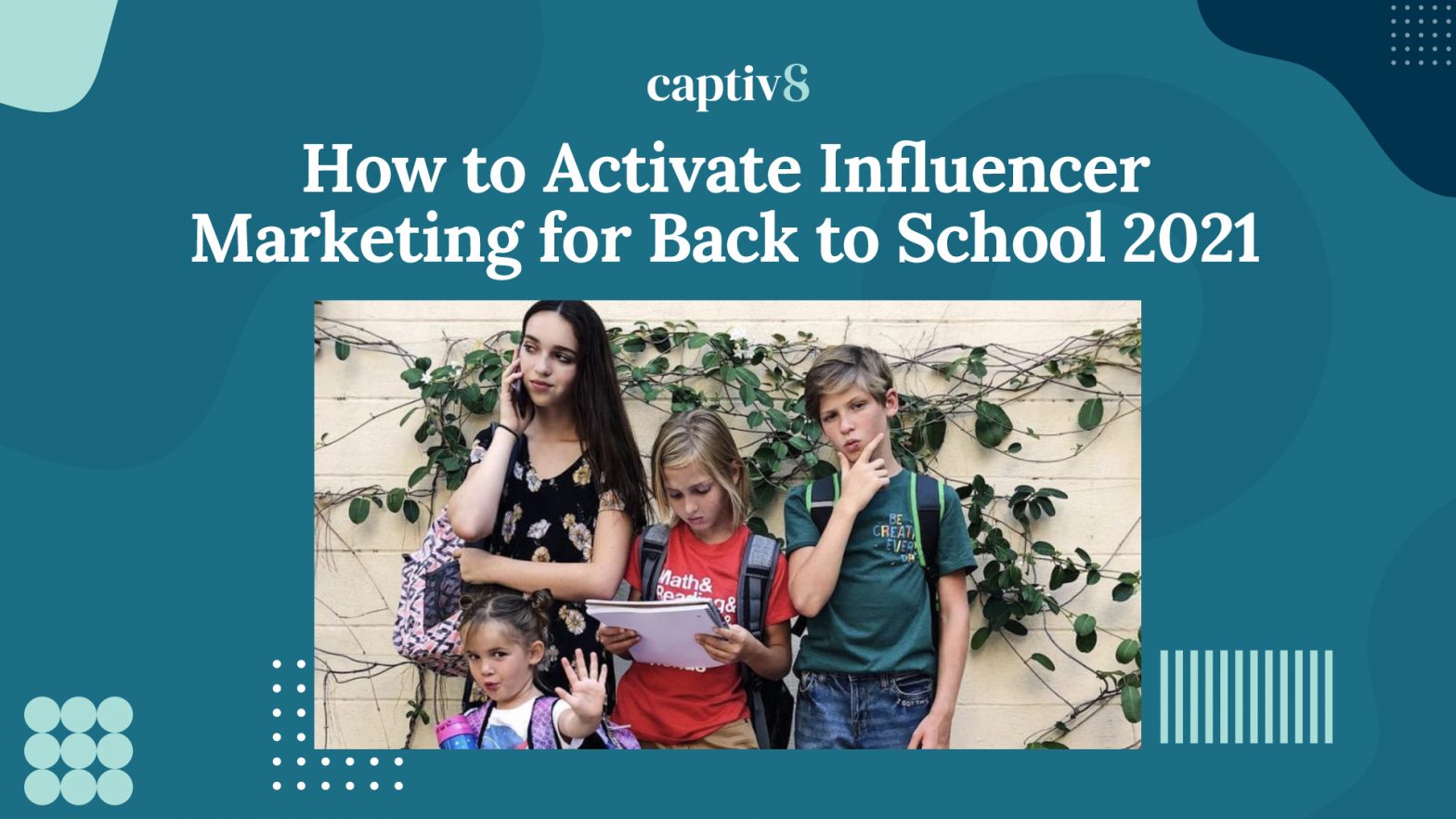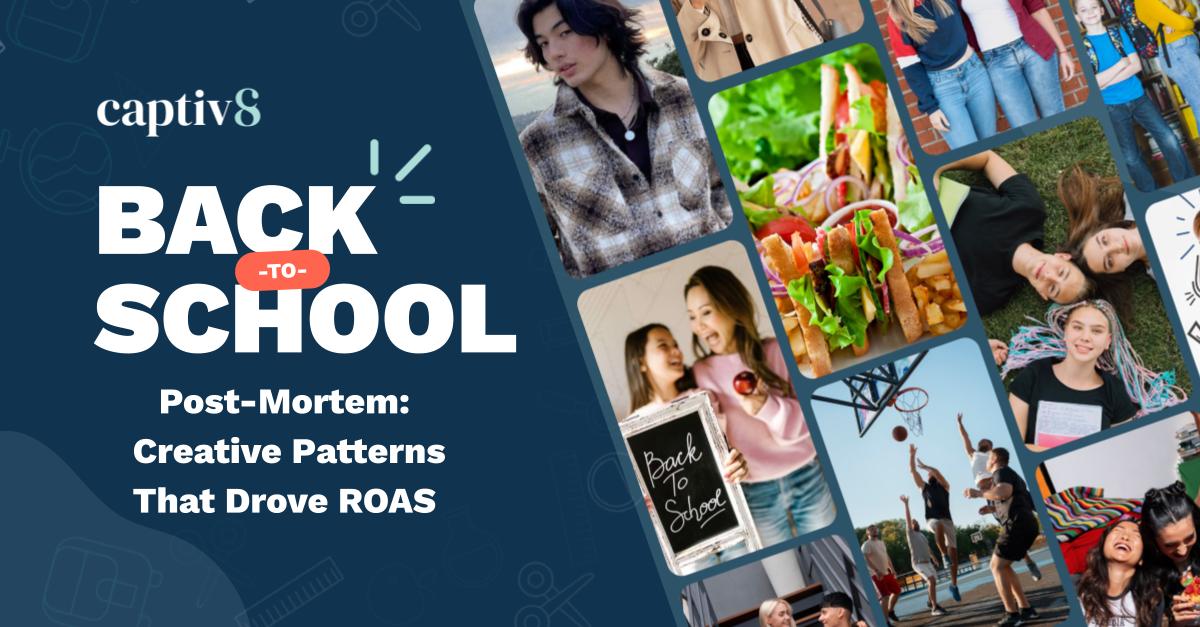How to Activate Influencer Marketing for Back to School 2021

For many, class is already back in session, get ready for that next back-to-school (BTS) rush. Want to be the brand that’s in style for back-to-school 2021? Implementing influencer marketing to your brand’s strategy will help you gain a leg up on this year’s competition.
In this report, we’ll discuss:
- The timeline for back-to-school shopping that marketers need to know to design successful campaigns.
- Demographics of current shoppers and what that means for marketing campaigns.
- Why marketers should get the most out of back-to-school shopping, especially surging online sales.
- Why back-to-school influencer marketing should be a key part of anyone’s strategy this year.
When to start thinking about BTS shopping
We often think about school starting in the fall. In reality, most back-to-school shopping starts right after the Fourth of July. Sales ramp up through the month of July, peak in August, and taper off by mid-September.
BTS demographics to focus on
The back-to-school shopping market includes students of all ages. However, most of what families spend is on older teens and college-age students. This is an important distinction for marketers because students ages 13-24 (Gen Z) also spend a significant amount of time on social media.
Thus, marketers must understand and leverage the role social media influencers can play in shaping students’ shopping behaviors as they prepare to go back to school. While many students won’t be spending their own money, 93% of parents say their Gen Z children influence their household purchases.
That means a strategic marketing campaign using back-to-school influencer marketing can significantly impact buying decisions. Students in the critical demographics of junior high, high school, and college pay close attention to the information they see online. And parents often consult with their kids about shopping decisions for back-to-school items.
Gen Z consumers use social media to discover the latest trends and make sure the items they buy are worth the money they spend. While most are not yet loyal to a specific brand, they do express interest in shopping with companies whose values match their own. After all, Gen Z already follows influencers who they believe have similar values to their own. So, partnerships with the right influencers immediately create a level of trust with these Gen Z consumers.
What does this mean for marketing campaigns?
These back-to-school influencer marketing partnerships also allow retailers a unique chance to introduce new brands and begin building loyalty. A strategic and dynamic relationship with influencers can significantly boost BTS sales in 2021. (This could have a lasting impact on future sales as well.)
Starting now, marketers need to identify influencers who:
- Have a substantial following of their target audience.
- Share the same values as both the audience and the company.
- Have a similar personality to the one that the company evokes.
- Rely on honest opinions and candid interactions with their followers.
Finding the right influencer who checks off all these boxes can be like finding a needle in a haystack. That’s why Captiv8 is here to help marketers find the back-to-school influencer marketing partnership that yields the best results.
Why back-to-school shopping is so critical for retailers
The back-to-school shopping market is a lucrative one for retailers.
In 2019 (pre-COVID-19), when the economy was strong and growing, surveys revealed that BTS shopping was likely to increase by about 2%. That’s not the whole story though:
- Online sales were expected to grow by more than 14% compared to 2018-19.
- Projected per-family spending went up from $696 in 2019 to $789 in 2020.
- A significant portion of the increase in per-family spending went toward electronics for remote learning.
- College students are a particularly lucrative BTS market, spending $1,059.20 per family and $67.7 billion per year.
Back-to-school shopping season is the second-largest for retailers behind the holidays, according to the U.S. Census Bureau’s shopping trends report. So while 2021 numbers from the National Retail Federation’s annual survey aren’t out quite yet, it’s likely that sales will remain high. That is especially true if most or all students are able to go back to school in person in the fall, and if the economy is growing as the COVID-19 pandemic fades.
For marketers, this means the 2021 back-to-school season has the potential to return to more normal spending patterns, where the majority of BTS shopping is for clothing and accessories. In the past, those categories made up 54% of total retail back-to-school spending and are likely to get back to that level again or even surpass it. Thus, retailers must be ready with campaigns that position their brand in the right place, which means being on social media.
With the changing landscape in mind, marketers need to determine the COVID-19 protocols for their target demographic’s location to create ads that are most relevant to their situation. Gen Z will scroll right past an Instagram ad for back-to-school sales on backpacks if they are still learning remotely.
The lasting impact of COVID-19
In 2020, 37% of parents said they planned to do most or all of their school shopping online. As with many of our shopping habits over the course of the COVID-19 pandemic, the convenience and access of online shopping will likely remain valuable even when in-person retail shopping is widely available and safe.
For that reason, retailers need to be prepared with back-to-school influencer marketing campaigns that:
- Facilitate mobile and online sales.
- Target students (and parents) on the social media channels where they spend the most time.
- Make online shopping easy and seamless (such as one-click checkouts and in-app shopping).
Strategies for an effective back-to-school influencer marketing campaign
Most Gen Z buyers haven’t solidified their brand loyalty yet. They are often influenced by what they see others buying or doing online. About 70% of Gen Z consumers follow at least one influencer on social media, from mega-influencers with millions of followers to nano-influencers with a smaller but highly engaged following.
Growing up in a noisy digital world, Gen Z consumers have a well-developed filter for ads. They don’t want to feel like they’re being sold something. That’s why back-to-school influencer marketing campaigns are so successful. Gen Z consumers interact with influencers as individuals, not as brands. They value influencers’ opinions and hold a high level of trust that traditional advertising simply cannot achieve.
The selling power of social media influence
Gen Z consumers on social media increasingly purchase items based on what they see on their social feeds. In fact, 88% say they learn about products they’re interested in buying on social media. Plus, 56% have made a purchase after seeing it on the feed of someone they follow. For advertisers, this is like a modern-day word-of-mouth testimonial, which has long been one of the most powerful marketing tools available.
With this in mind, marketers must craft social media ads to be hyper-informative and catchy in order to motivate them to buy. The digital testimonial must also include some of the same characteristics as the traditional method – the honesty and reliability of word-of-mouth testimonials that consumers often feel when getting information from a fellow consumer. Since influencers are built on a foundation of trust, looking at social media ads through the lens of testimonials will make back-to-school influencer marketing easier to implement, especially if marketers have the right partner to facilitate the process.
Don’t forget about parent influencers
People talk a lot about the amount of time teens spend on social media. However, it’s important not to forget another key group of consumers to reach through influencers: parents. In 2020, 87% of moms used social media. Even more important, 80% of moms say they use social media for product recommendations.
Mom influencers offer a huge opportunity for savvy brands to target parents preparing for the back-to-school shopping season. Product recommendations, testimonials, and strategic partnerships can pay off for brands that want to sell products targeted at a younger audience (elementary age) where mom is making the decision.
Successful brands using influencers for back-to-school shopping
Brands of all sizes use back-to-school influencer marketing. In 2020, Hollister launched a “Jeans Lab” ad with mega-influencers Charlie and Dixie D’Amelio. The ad racked up 2.5 billion views on TikTok in just six days. It was part of a larger campaign where the D’Amelios designed their own custom jeans. Stores also included their “stamp of approval” on the display.
Another major back-to-school retailer, Target, got in the game with the Quinn sisters, who shopped the store aisles, showed off their favorite finds, and shopped for each other.
These examples offer insight into how today’s consumers want to interact with people in a real way. They consume information that aligns with their own experiences and goals, not the overly-produced version of the world that appears in traditional ads.
One important note to remember in any back-to-school influencer marketing campaign is authenticity. People follow their favorite personalities on social media and build a lot of trust through their virtual interactions. Brands need to find the right fit for their own products and brand values. That doesn’t always mean getting the biggest influencer celebrities. Sometimes it’s a matter of working with influencers who have smaller followings but who are a better fit for a brand’s image and message. Captiv8 can help marketers find the right influencers based on their budget and products.
Get started planning a BTS campaign today
With children and parents gearing up for BTS shopping in a few months, now is the time to start planning an advertising strategy. Back-to-school influencer marketing is one of the most effective ways for reaching these shoppers and capturing market share during one of the biggest shopping seasons of the year.
- The target audience has over $140 billion in spending power. A sizable portion will be spent on back-to-school items this year between mid-July and mid-August.
- Influencers offer brands a unique opportunity to reach an already engaged group of potential customers.
- Influencer and brand alignment are critical for achieving success.
Interested in launching a back-to-school influencer marketing campaign? Visit Captiv8.io and find out how we can help you succeed in BTS marketing for 2021.
![Be the Best-Selling Brand this Back to School Season [On-Demand Webinar Recording] Back-to-School Influencer Marketing](https://captiv8.io/wp-content/uploads/2023/06/230613_captiv8_bts_webinar_promos_linkedin_520x320@2x_v4.jpg)
![The Top Electronics Brands to Watch for Back-to-School Season 2023 [Download] Electronics for Back to School Shopping](https://captiv8.io/wp-content/uploads/2023/05/Screen-Shot-2023-06-12-at-2.44.52-PM.jpg)
![The Top Snack Brands to Watch for the Back to School Season 2023 [Download] The Top Snack Brands to Watch for the Back to School Season 2023 Industry Benchmark Report](https://captiv8.io/wp-content/uploads/2023/07/Snack-Benchmark-Report.jpg)
